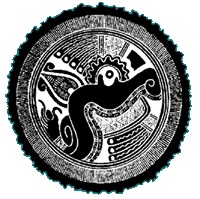As camera technologies advance, photography continues to become a more interesting option for
birdwatching activities. Today, one does not have to be a professional or invest thousands into a hobby to take good pictures of birds. Many of our visitors at
Estacion Biologica Laguna de Apoyo come especially for the birds, and some of them even take great photographs. Here, we present the second blog entry highlighting the photography of
birdwatchers Jesse Bickley and Anna James.
 |
| Great Kiskadee (Pitangus sulfuratus) is very common in the Laguna de Apoyo Nature Reserve and throughout wooded areas in the Pacific region of Nicaragua. Photo Jesse Bickley and Anna James. |
 |
| The Keel-billed Toucan (Ramphastos sulfuratus) are always pleasant discoveries here, where they are easier heard than seen. Great photo shots of this species may be difficult, because they prefer forest canopy. Photo Jesse Bickley and Anna James. |
 |
| Long-tailed Manakins (Chiroxiphia linearis) males dance and sing to attract a mate. The senior male dances in tandem with a junior male who requires up to four years to reach sexual maturity. Photo Jesse Bickley and Anna James. |
 |
| The male Elegant Trogon (Trogon elegans) makes an unattractive growl but is quite a beauty to see. Photo Jesse Bickley and Anna James. |
 |
| The Black-headed Trogon (Trogon melanocephalus) is quite common on the north side of Lake Apoyo, where Estacion Biologica is located. Photo Jesse Bickley and Anna James. |
 |
| Our national bird is the Turquoise-browed Motmot (Eumomota superciliosa). The abundance of steep banks with loose, volcanic soils make Laguna de Apoyo Nature Reserve ideal habitat for this bird. Photo Jesse Bickley and Anna James. |
 |
| The pendulum-like swing of the tail of the Turquoise-browed Motmot (Eumomota superciliosa) is thought to discourage predators. Photo Jesse Bickley and Anna James. |
 |
| The Clay-colored Thrush (Turdus grayi) acts and even sounds similarly to the American Robin of North America. Photo Jesse Bickley and Anna James. |
 |
| Male Summer Tanager (Piranga rubra) make fill our forest with bright color about seven months per year. It accompanies hundreds of other birds in yearly migration, reproducing in North America. Photo Jesse Bickley and Anna James. |
 |
| The red bill and rusty tail distinguish this bird as the Rufous-tailed Hummingbird (Amazilia tzacatl), much more common in Eastern Nicaragua than in the forests of Laguna de Apoyo Nature Reserve. Photo Jesse Bickley and Anna James. |
 |
| The Great Kiskadee is very common in forest edge throughout the Pacific region of Nicaragua. Photo Jesse Bickley and Anna James. |
 |
| The Chestnut-capped Warbler (Basileuterus delattrii) is the only year-round resident warbler of the reserve. Photo Jesse Bickley and Anna James. |
 |
| Cuckoos such as the Groove-billed Ani (Crotophaga sulcirostris) have a distinctive smell which may serve to protect them from predation. Photo Jesse Bickley and Anna James. |
 |
| The Montezuma Oropendola (Psarocolius montezuma) nest communally. Males and females divide the work around the nesting site. Photo Jesse Bickley and Anna James. |
 |
| No photo essay on birds in Nicaragua would be complete without the Black Vulture (Coragyps atratus), among the most visible of any bird in the country. Photo Jesse Bickley and Anna James. |
Jesse and Anna also took some great photos of
birds associated with Lake Apoyo, too. If you would like to schedule a
birdwatching tour with one of our specialized birdwatching guides, please contact us!
Please
contact us and let us know what you think of our blog, or post a comment below!
















No comments:
Post a Comment